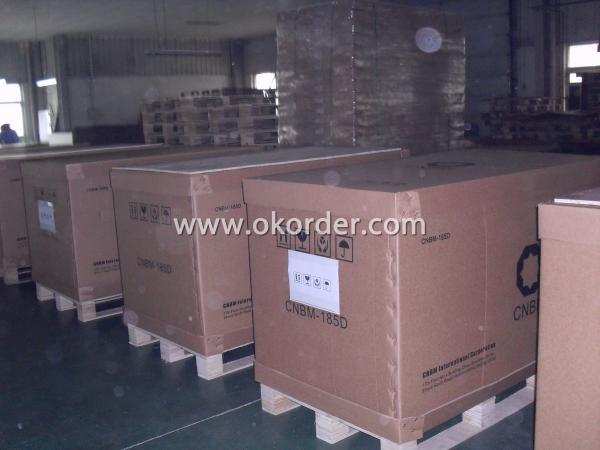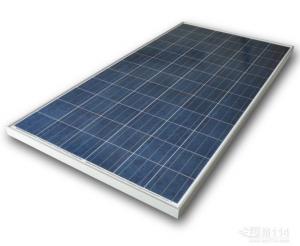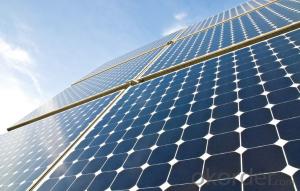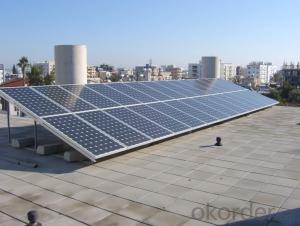Solar Panels Tempe Mono Solar Panels CNBM 235W
- Loading Port:
- China Main Port
- Payment Terms:
- TT or L/C
- Min Order Qty:
- 1 Sets watt
- Supply Capability:
- 10000 pcs per month watt/month
OKorder Service Pledge
OKorder Financial Service
You Might Also Like
Introduction of Mono solar panels CNBM (235W)
CNBM Solar photovoltaic (PV) Panel is designed for large electrical power requirements. It is the optimal choice for both on-grid and off-grid power systems. CNBM Solar panel offers high performance of power per square foot of solar array. Monocrystalline silicon(c-Si): often made using the Czochralski process. Single-crystal wafer cells tend to be expensive, and because they are cut from cylindrical ingots, do not completely cover a square solar cell module without a substantial waste of refined silicon. Hence most c-Si panels have uncovered gaps at the four corners of the cells.
Characteristics of Mono solar panels CNBM (235W)
I.Solar Cell : High efficiency crystalline solar cell. Even if under the weak light, the solar module can produce maximum power output.
II.Tempered glass (toughened glass): Anti-reflecting coating and high transmission rate glass increase the power output and mechanical strength of solar module.
III.EVA and TPT: Using high quality EVA and TPT to prevent destroying and water.
IV.AI frame: Without screw, corner connection. 6 holes on the frame can be installed easily.
V.Junction box: Multi function junction box with water proof.
VI.Long lifetime: ≥25 years; Less power decrease.
VII.Good performance of preventing from atrocious weather such as wind and hails.
VIII.Resisting moisture and etching effectively, not effected by geology.
IX.The certificate issued by international authority: UL, TUV, IEC, VDE, CE.
Standard Test Conditions of Mono solar panels CNBM (235W)
The opto-electrical specifications shown below are stabilized values being measured at Standard Test Conditions, Irradiance: 1000W/m2, Spectrum: AM1.5 at 25°C, The info below is subject to manufacturing tolerances. Where appropriate minutes of measurement are available and are used for the dimensioning of the installation.
Advantages of Mono solar panels CNBM (235W)
• CNBM Solar performance guarantees for 25 years
• 10 years guarantee for workmanship
• Timeliness of delivery
• Quality Products certified (TÜV, UL, CE, VDE, ISO)
CNBM International Corporation's products including Monocrystalline Solar Panel, Polycrystalline Solar Panel have received and enjoyed famous reputation in many countries and regions in the world .As a solar panel manufacturer in China, we strive to provide our customers with excellent service, superior products and unmatched value.
Datasheet of Mono solar panels CNBM (235W)
Characteristics of Mono solar panels CNBM (235W) | |||||
Max Power Voltage Vmp(V) | 30.3 | 30.8 | 31.1 | 31.4 | 31.85 |
Max Power Current Imp(A) | 7.60 | 7.64 | 7.73 | 7.81 | 7.85 |
Open Circuit Voltage Voc(V) | 36.1 | 36.6 | 37 | 37.3 | 37.68 |
Short Circuit Current Isc(A) | 8.50 | 8.55 | 8.65 | 8.75 | 8.85 |
Max Power Pm(W) | 230W | 235W | 240W | 245W | 250W |
Temperature Coefficient of Cells Mono solar panels CNBM (235W) | |
NOCT | 45℃ ± 2℃ |
Temperature Coeffucients of Isc (%/℃) | 0.0492 |
Temperature Coeffucients of Voc (%/℃) | -0.3374 |
Temperature Coeffucients of Voc (%/℃) | -0.4677 |
Mechanical Data of Mono solar panels CNBM (235W) | |
Dimension | 1638 × 982 × 40 mm |
Weight | 19.5 kg |
No. of Cells and Connections | 60 (6 ×10) |
Tolerance | 0 ~ + 5 W |
Cell | Monocrystalline Cell 156 × 156 mm |
Packing | 624 Pcs/40ft(H) Container |
Limits of Mono solar panels CNBM (235W) | |
Operating Temperature | -40℃ to +85℃ |
Storage Temperature | -40℃ to +85℃ |
Max System Voltage | 1000VDC(IEC) / 600VDC(UL) |
Guarantees of Mono solar panels CNBM (235W) | |
Products Guarantee | 12 yrs free from defects in materials and workmanship |
Performance Guarantee | No less than 90% within 10yrs and no less than 80% within 25yrs |
Certificates | TUV(IEC61215&IEC61730),VDE(IEC61215&IEC61730),UL,CE |
IV Curve of Mono solar panels CNBM (235W)

The data does not refer to a single module and it is not part of the offer
It is only for comparison only to different module types.
Test Conditions of Mono solar panels CNBM (235W)
The opto-electrical specifications shown below are stabilized values being measured at Standard Test Conditions, Irradiance: 1000W/m2, Spectrum: AM1.5 at 25°C, The info below is subject to manufacturing tolerances. Where appropriate minutes of measurement are available and are used for the dimensioning of the installation.
Picture 1. The factory indoor sight of Mono solar panels CNBM (235W)

Picture 2 the package of the panels of Mono solar panels CNBM (235W)

- Q: What is the payback period for solar panels?
- The payback period for solar panels varies depending on factors such as the cost of installation, energy savings, and applicable incentives. On average, it ranges from 5 to 15 years, but advancements in technology and decreasing prices are making the payback period shorter.
- Q: What are the different applications for solar panels for residential use? How many should I purchase if the avg panel produces 80 watts .
- Let me start off by saying we (my family and I) live completely, 00% “off of the grid and are completely self sufficient” The house is built utilizing natures natural elements, in the shape of an octagon with 8ft wide arch doors on every wall to catch every angle of wind (typical 4 sided homes have half the chance as one with 8 sides.
- Q: How do solar panels affect the electricity bill?
- Solar panels can significantly reduce or even eliminate electricity bills by generating renewable energy from the sun, thereby reducing the reliance on grid-supplied electricity. When solar panels produce more energy than is consumed, excess energy can be fed back into the grid, resulting in credits or reducing future bills through net metering programs.
- Q: Do solar panels require regular cleaning?
- Yes, solar panels do require regular cleaning to ensure optimal performance. Dust, dirt, and other debris can accumulate on the surface of the panels over time, blocking sunlight and reducing their efficiency. Regular cleaning helps to remove these obstructions and maximize the energy output of the solar panels.
- Q: I was looking at thin flexible solar panels as solar panels 500w a option to upgrade a 20w solar panel I have permanently mounted to the roof of a home made camper van.Why I was thinking flexible is at just 2mm thin they can be glued down and being flexible they will follow the contour of the rounded shape of the roof of my camper (boxy standard solar panel spoils the lines a little)Another reason is no glass to brake when traveling on dirt tracks(though I am surprised mine hasn't broken yet after thousands of km on corrugated dirt roads). Finally there is a weight saving at only /3 the weight or less then a standard glass panel.There are different grades of flex PV some of the more expensive ones are very flexible with extremely thin backing at around .5mm The ones I was looking at are cheaper and at around 2mm with a thin flexible aluminum backing.$250 is about the going rate for 20w OKorder job. Below is a pic of a smaller one 60w or so.Has anyone had any experience with them?
- but it's very interesting and I wanted to ask you. In your case this is good solution, but I saw flexible panels in OKorder much cheaper than 250$. This is the price of standard solar panel 20w. Maybe your panels with better efficiency? I know that flexible panels are less than half efficient than regular panels, thats why you need twise more area to get the same output. What is your usage of this energy in this van? I know there are many ideas of solar cars, but if this solution is efficent enough today? Thanks!
- Q: first of all, to be honest i have totally no idea on how a solar panel works.my task is to design something like a solar powered street lamp which store sun energy during day time and convert it into electrical energy then light energy so that the lamp can work during night time.any ideas on how to design the solar panel? which can store enough or more enegry in case there is no sunlight another day. and low cost as well :D
- image voltaic panels do no longer shop capability, they basically generate it. in case you opt to shop capability you like a battery economic enterprise of a few sort to get you for the time of the night and each time the sunlight isn't shining. in case you have somewhat extra in the fee selection you would be able to desire to look at a geothermal equipment to your place's heating and cooling needs. they are distinctly useful structures and you'd be able to supplement notwithstanding you like. notwithstanding you do, in spite of the indisputable fact that i'm hoping you have a sturdy construction envelope in place already. image voltaic panels are cool, yet once you have a leaky homestead, you're nevertheless no longer getting the final out of your panels. Do the extra mundane stuff first. Insulation, homestead windows, and climate-tight doorways.
- Q: I have some property off the grid and am looking to add solar power
- By okorder /
- Q: wondering if i should get them?? not sure if its worth leasing? also anyone know anything about solar city?
- They are absolutely worth it. I had a town house in Boston with solar panel shingles and they were able to supply enough energy for me to feed back the grid-- literally making money off of them. I am building a very large home in the suburbs now and we are doing solar shingles on that. Our contractor estimated that with our geotherm heat pump and energy efficient lighting we should still be able to throw back more energy to the grid all year round! As for leasing it is not worth it. For one thing, most leasing contracts prevent you from selling your energy to the grid yourself but rather they take a cut. But a bigger issue: the government gives you a tax credit on solar panel installations but only if you purchase them! I did the math myself the first time I did solar panels and with the tax credit I saved 25% over leasing. Something else to consider is that with your own panels you can connect a variety of other systems to your home and modify them as needed.
- Q: hey, i am wanting to help our earth a little bit, and I was wondering how to do a solar panel connection for powering my home.... i just want to reduce my energy bill a little bit, Would these solar panels work?and how would i connect them?
- I okorder Hope this helps.
- Q: I'm thinking of doing solar panel but i don't know how much they are i need help! please!
- no one has answered because you asked a question that cannot be answered. It is exactly the same question as how much is a car?. Do you want a passive solar heating panel, a solar electric panel, .5 Volts, ,000,000 BTUs, do you want just the panel or the panel installed and functioning, or what? the answer is between $5 and $5,000,000.
Send your message to us
Solar Panels Tempe Mono Solar Panels CNBM 235W
- Loading Port:
- China Main Port
- Payment Terms:
- TT or L/C
- Min Order Qty:
- 1 Sets watt
- Supply Capability:
- 10000 pcs per month watt/month
OKorder Service Pledge
OKorder Financial Service
Similar products
Hot products
Hot Searches
Related keywords




























